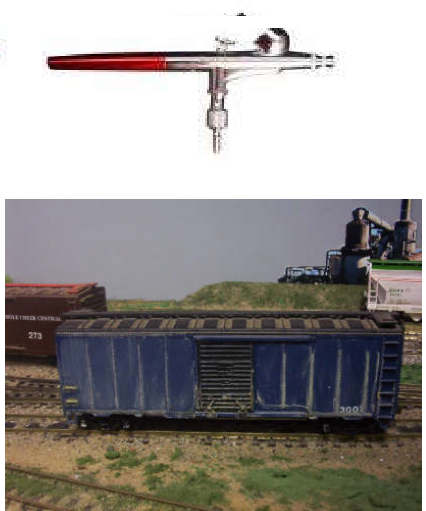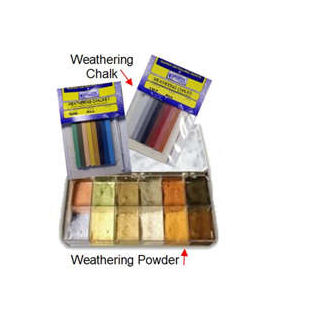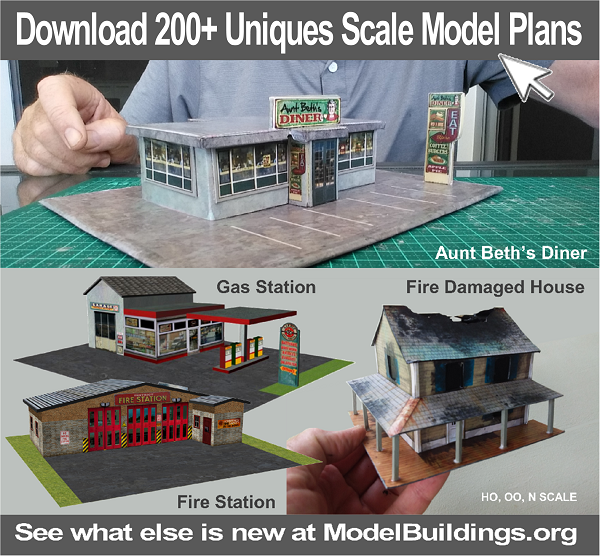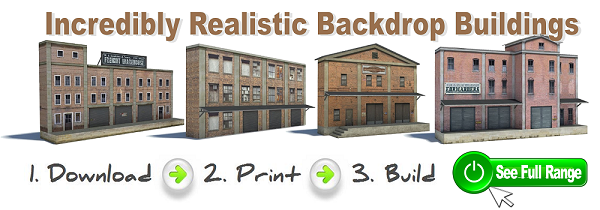3 Basic Weathering Techniques For Model Railroads: Chalk, Washes and Airbrushing
The following three weathering techniques can be used for scenery, structures, and rolling stock on model railroads, however they are not required when purchasing the plans for downloaded buildings and structures featured on this website. All plans available on this site are photographic representations of actual real world structure so don’t require any weathering, apart from possibly touching up some edges with a paint brush, pencil, chalk, or maybe a felt tip pen. With that noted, here are the three weathering techniques commonly used on model railroads. © Copyright http://www.modelbuildings.org All rights reserved.
Chalks are applied as a powder. This means that you will want to scrape the chalk over blade of a modeling knife or a small square of drywall sanding screen onto a sheet of paper to work from. If you wish, you can make enough to store in a small bottle or container for future use, but it doesn’t take much time to make enough powder to weather whatever project you have going at the moment. You’ll probably want to make several small quantities of different colors at the same time for different effects.
1. Chalks For model Railroads
Artists’ chalk comes in a huge variety of colors. A good craft store should give you a fine selection to choose from in many colors for just a few dollars. You should get some pastels and also some of the gray, browns, and blacks that are used for silhouettes and monochrome line drawings. They come in short sticks which are easy to work with and store. There are also model weathering powders that are commercially available.
Weathering powders are different from chalks in that they are manufactured from ‘real’ rust and some other weathering agents 100 times finer than chalk. They are blended with an adhesive so will stick to almost any surface.
Some modelers prefer to spray the object with a light coat of Testor’s Dullcote to prepare the surface. Others just begin with the chalk. In either case,
apply the chalk with a fine tipped, clean dry brush for maximum control. Dirt and grime tends to hide in nooks and crannies, so this is where to begin. Paint the chalks in and around seams or joints on the model. Try to find a color photograph of a similar object on the Web, and follow the weathering pattern on the real thing. There is no right or wrong way of weathering with chalk because you can always clean it off and start over again.
Apply more layers and colors as you work to get the right effect. At some point early in the process, you will probably want an overall base coat of some rust or dirt color to darken the whole object.
When you are satisfied with the effect, finish off with a coat of Testor’s Dullcote to set the chalk. After it dries, if you wish, you can add more coloring. Just be sure to set that final application with Dullcote to
2. Washes For model Railroads
Washes are basically thinned paints. Floquil and Polyscale are two of the more popular model paint manufacturers; you might want to prefer the water based paints for ease of cleanup and to insure that no solvents in the paint damage plastic parts. Both paints come in descriptive colors that are unmistakably used for weathering, such as Grimy Black, Dust, Rust and Mud. A nice black wash that is useful all over the layout is a mixture of alcohol and India ink. It is good for scenery modeling as well as weathering. In fact, washes are a staple of all scenery coloring. Nature is subtle; washes do subtle very well.
The technique for paint weathering is similar to that used for chalk weathering, however the washes will tend to run. This is not necessarily a bad thing, because water weathering of objects causes that same effect. Another benefit of the wash technique is that you can do detail work. Car trucks can be weathered with paints more easily than chalks, for example. In some cases, full strength paint or a very thick wash is a better technique than chalking and Dullcote.
There is also a paint technique called dry-brushing that can be used to great effect. Use a stiff brush and wipe most of the paint off on a paper towel, then make light vertical streaks on the object. Use very little paint so the effect is subtle. This same technique is used to make light highlights on terrain and especially rock faces when constructing scenery.
3. Airbrushing For Model railroads
Airbrush paint (again, Floquil or Polyscale) can be either thinned or go on full strength using the airbrush mixture control to adjust the paint density. Airbrushing is a skill worth mastering before going to work on your best pieces, so find something to practice on. Old models, small wood planks, even cardboard can be used to master controlof the brush and the mixture.
You can paint incredibly fine detail with an airbrush. If you also use water based paint, you can wipe or wash off what you’ve done and start over if you don’t like the effect.
Use light strokes with the mixture set for a very fine spray. Thin layers are the key – it’s easier to go over an area several times to get a darker coat rather than trying to paint that effect all at once. It’s also easier to blend colors together.
Airbrushing is a great tool for doing a lot of rolling stock weathering in a short time. You can create a basic weathering effect on a lot of cars, then concentrate on more detail over time while your railroad looks realistic right from the start. Because you have so much control with an airbrush, locomotive detailing is one of the better applications. Creating exhaust, heat damage, road grime, grease, and rust is all easy to do once the use of the brush is mas

Airbrushing is an exceptional technique for weathering rails. Starting out with full strength rust brown, you can paint the rails, then paint oil streaks between the rails on the ties to show fuel and lubricant drips from rolling stock. On scenery, highlights of rock outcroppings, or subtle shading effects can be done with a great deal of precision.
When weathering, don’t forget the roof of the object, because the roof really takes a beating from the weather. Boxcar and locomotive roofs and
hoods don’t stay the original color very long in service. Rust and grime is deposited almost immediately from airflow over the car. On buildings, the alternation between hot sun, rain, wind and snow begins to break down the material pretty quickly as well. A building roof a few years old will show rust and dirt streaks which an airbrush can apply very easily. If you do a search on the internet for pictures of layouts, you will see that the most realistic of all use extensive weathering of nearly everything on the layout. Don’t overlook weathering your model automobiles on the layout, by the way. Have you ever seen a city street filled with cars that look like they just emerged from the showroom?



